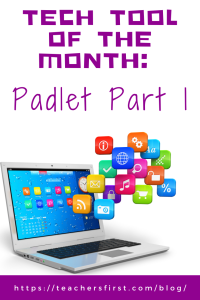Padlet, a versatile and user-friendly online collaboration tool, empowers individuals and teams to create virtual boards for sharing ideas, brainstorming, and organizing information. Create a board from scratch or choose from customizable templates, like timelines, maps, KWL, and storyboards. Padlet’s AI features support creating custom interactive activities based on topic, grade level, standards, or teaching objectives. Through its intuitive interface, users post digital sticky notes containing text, images, videos, links, polls, and files onto a shared workspace, fostering seamless collaboration and creativity.
Customize the appearance and format of your Padlets using options such as allowing comments on posts, moderating posts and comments before they are publicly posted, and sorting options for easier viewing. Recent updates include the option to import your current Flips to Padlet. Read all about it here. Free accounts allow you to make three Padlets, including themes, images, premium wallpapers, and cross-device support for uploaded videos. You can permanently delete an old Padlet to create a new one.
Padlet is a freemium device-agnostic tool available on the web and as an Android and iOS app. You can access your work from any device or move between several devices. Please note that the app and web versions vary slightly.
Applying the Triple E Framework
The Triple E Framework, created by Dr. Liz Kolb, states that “effective technology integration begins with good instructional strategies and not fancy tools” (tripleeframework.com). Dr. Kolb wrote a book, Learning First, Technology Second (ISTE, 2017), which lays out the three main uses of technology in education: to Engage, Enhance, or Extend learning goals. We can use this framework to decipher why we use specific classroom tools. Here is a rubric based on the Triple E Framework you can use to evaluate whether Padlet (or any other technology) is a good fit with your learning goals and whether you should use it in your lesson.
- Engage in learning goals: The students can focus on the content and Padlet creation as there are no advertisements or other distractions. Also, the students are active rather than passive learners, creating their posts and adding their text, audio, drawings, and more.
- Enhance learning goals: Padlet creates pathways for students to demonstrate their understanding of the learning goals in a way they cannot do without technology. Students can virtually collaborate in real time. They can also add video, audio, images, drawings, and more. Many of these would only be possible with technology. The tool also offers scaffolding, as students can redo/edit their posts until they are satisfied.
- Extend learning goals: Dr. Kolb describes extended learning as an opportunity for students to learn, connect, and collaborate outside the regular school day and as a way to create a bridge between school learning and everyday life experiences. Students and teachers can easily collaborate with Padlet during a remote learning day. Using Padlet also empowers students to build skills they can use in their future and everyday lives as they practice articulating with descriptive language to create their posts and using technology to create a product. Both of these skills can help students in future careers and courses.
SAMR Connection
The SAMR Model, by Dr. Ruben Puentedura, suggests that technology implementation has four levels. Therefore, we can use this model as a guideline to analyze how we use technology tools in the classroom. For example, using Padlet with your students could be at all four SAMR levels, depending on how they use it. Let’s look at an activity where students create a post sharing the character that they best relate to from a novel read in class.
- Substitution: The substitution level is the most basic level of SAMR and refers to when technology acts as a direct substitute without any functional improvements. An example would be having students use Padlet to create the post rather than just drawing on a Post-It note or paper.
- Augmentation: At the augmentation level, the technology acts as a direct substitute and includes some functional improvements. Student posts can be taken to the augmentation level using Padlet features that are unavailable without technology. For example, students can record themselves speaking, draw virtually, and have the option to upload images and videos,
- Modification: The level of modification is when the technology allows for significant task redesign. For example, we could modify our Padlet image activity by having students add their posts and comment on other students’ posts using text, images, and other media. This tool allows for real-time collaboration.
- Redefinition: At the redefinition level, technology allows for the creation of previously inconceivable new tasks. We could take our Padlet post activity to this level by having students upload a link to a video that exemplifies their character or by having students embed the Padlet on a more social platform, such as a class website or a Google Site, and allowing the Padlet to be seen by a more global audience (and parents).
Take advantage of Part 2 of the Tech Tool of the Month: Padlet, where we’ll discuss using the tool and classroom ideas. In the meantime, let us know how you have used Padlet in your education setting in the comment section below.


